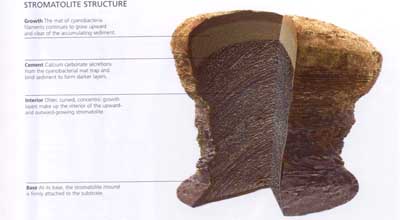 Stromatolite Anatomy
Stromatolite Anatomy
|
Precambrian
Fossils in the
Mescal
Limestone
Algal
Member
|
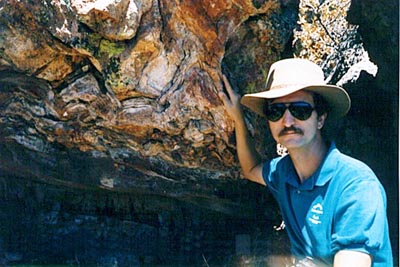 The Author at stromatolite locality in Young, Az.
The Author at stromatolite locality in Young, Az.
|
Updated 9/16/16
 | The magnificently
bedded layers of Mescal Limestone outcrop extensively near the
town of Young, and the Roosevelt Lake area. In particular, the
30 - 100 feet thick Algal Member of the Mescal contains locally
abundant bioherms of Stromatolites and algal mats. Stromatolites
as you may know are the layered remains of cemented sediment
from growing layers of cyanobacteria - Blue / Green Algae. We
have found silicified stroms near Young and loads of calcified
stroms in the Roosevelt Lake area. Many other interesting sedimentary
structures were also noted, including wave ripples, ventifacts,
massive chert beds of a beautiful red and orange coloration,
cross bedding, but never anything like worm burrows or grazing
traces of anything that might be munching on the stroms. Identifying
the genus or species of such poorly preserved remains is always
problematical, however in the Geological Survey Paper 566 - "Younger
Precambrian Geology in Southern Arizona", Andrew Shride
identifies the stroms found throughout the Algal member as "Collenia
frequens (Walcott)". You know Walcotts name - He discovered
the Burgess Shale in British Columbia. |
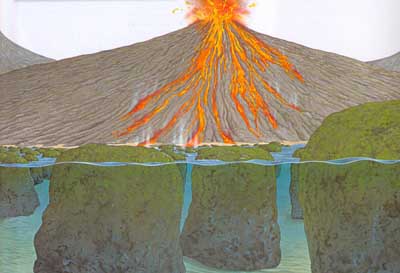 Click image to see Full Size
Click image to see Full Size
| During
the Precambrian Mescal Limestone time, the land was totally barren
of all life. Only in the sea did we find life, as in this near
shore setting we can see the stromatolites mostly submerged at
the tide line. |
Silicified specimens from the Young area.
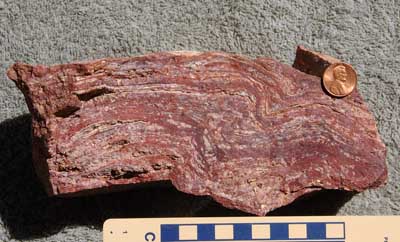 Click image to see Full Size
Click image to see Full Size
| One
of the larger specimens we found was this gem - a beautiful cross
section of a stromatolite mound preserved in red and white cherts. |
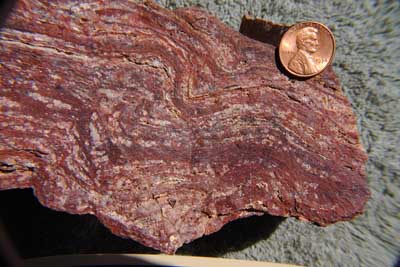 Click image to see Full Size
Click image to see Full Size
| Close
up showing folds and layers. Often we can find fossilized algal
filaments in the associated chert layers, I have yet to try this
with the Young specimens. |
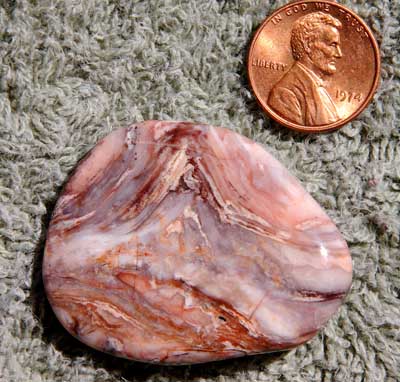 Click image to see Full Size
Click image to see Full Size
| This
is a specimen that was put into a rock polisher and brought to
a smooth and brilliant finish. Such specimens are perfect for
microscopic study of the layers. A perfect little strom mound
was captured in this unique specimen! |
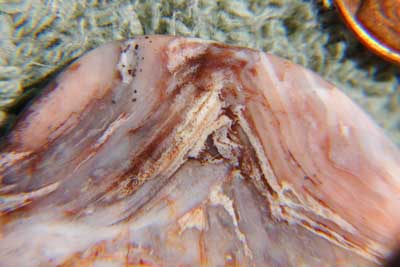 Click image to see Full Size
Click image to see Full Size
| Macro
lens close up reveals a bit more, but there is far more to see
here... |
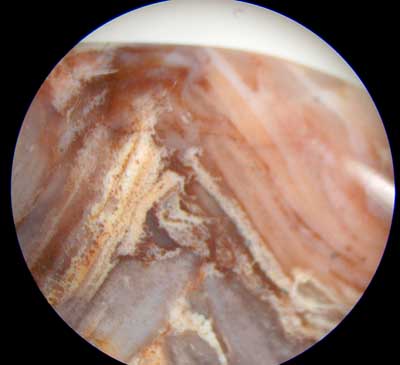 Click image to see Full Size
Click image to see Full Size
| 10x
microscope examination starting to reveal small round blebs in
the layers. More to come... |
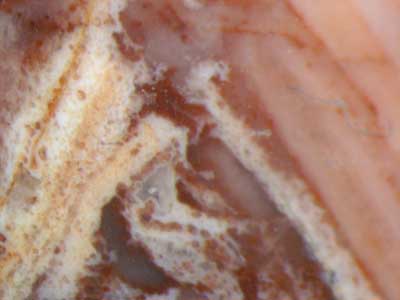 Click image to see Full Size
Click image to see Full Size
| 20x
close up shows the round silica blebs clearly as small spherical
bodies in the layers. I would interpret these as voids in the
original structure. |
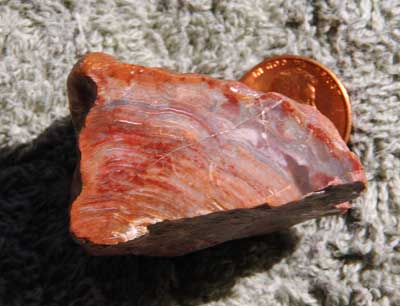 Click image to see Full Size
Click image to see Full Size
| Another
polished specimen - this one is sanded flat on a grinding wheel
and polished for close up examination. |
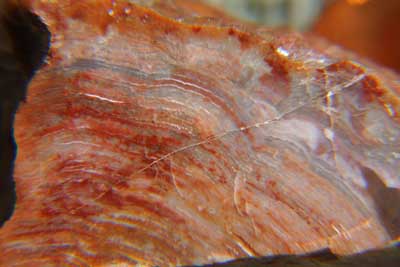 Click image to see Full Size
Click image to see Full Size
| Some
very fine details are starting to emerge in this camera lens
macro shot. |
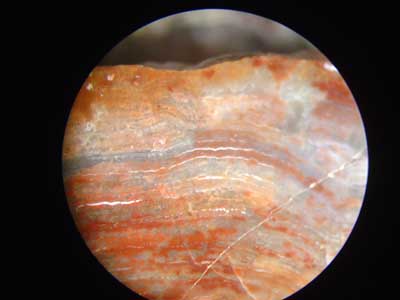 Click image to see Full Size
Click image to see Full Size
| 10x
view shows intricate banding, and small dark blebs. |
 Click image to see Full Size
Click image to see Full Size
| 20x
view shows the small round structures well. |
 Click image to see Full Size
Click image to see Full Size
| Larger
hand sized specimen showing a huge number of layers to form this
softball sized strom head. |
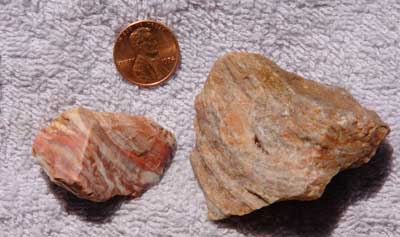 Click image to see Full Size
Click image to see Full Size
| A
few small specimens showing the range in colors for silicified
stroms. |
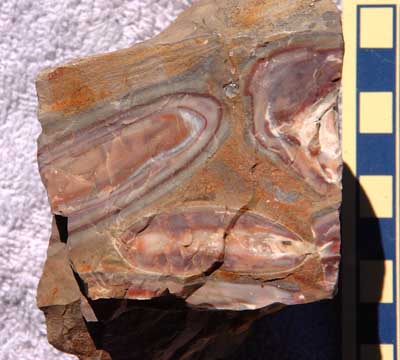 Click image to see Full Size
Click image to see Full Size
| We
found this type of preservational structure on occasion. My initial
thoughts are round ocean bottom rolling stromatolites called
Thrombolites. They seem to have similar layering to the cone
shaped ones, and are in the exact same strata. |
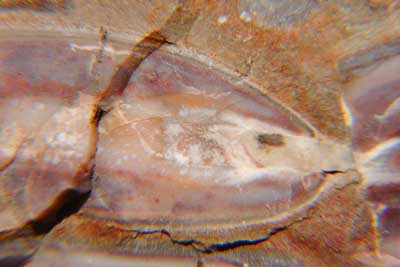 Click image to see Full Size
Click image to see Full Size
| Close
up of possible thrombolite. |
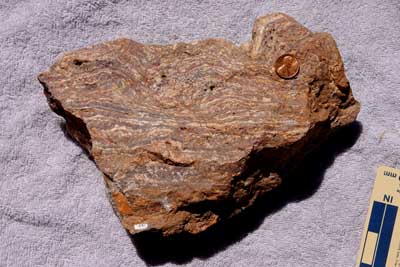 Click image to see Full Size
Click image to see Full Size
| Very
nice large and highly folded strom. |
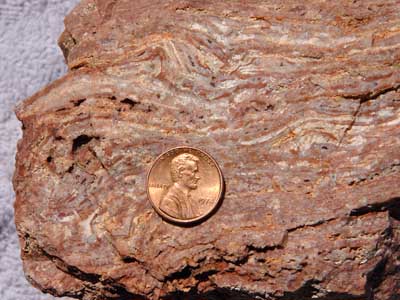 Click image to see Full Size
Click image to see Full Size
| Close
up of layers of dark red chert interspersed with white and cream
colored cherts. |
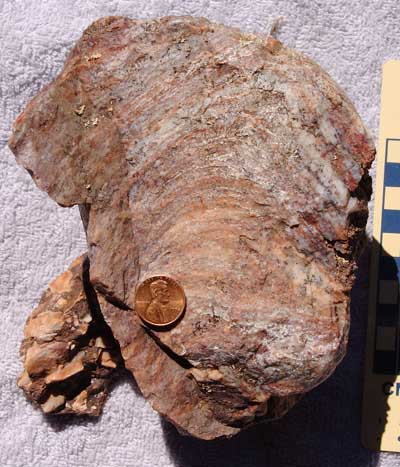 Click image to see Full Size
Click image to see Full Size
| A
stunning strom head, mostly seen in cross section here. You can
see the evolution of the shape as it grew upwards. |
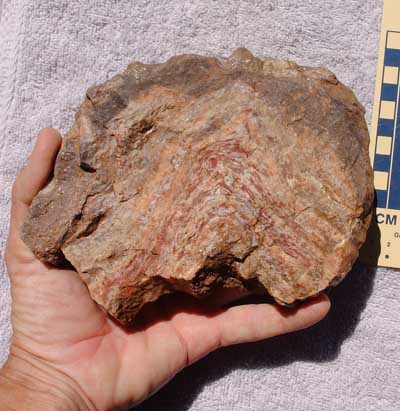 Click image to see Full Size
Click image to see Full Size
| A
complete head in cross section! Such finds are not too common,
mostly you find broken pieces and fragments. |
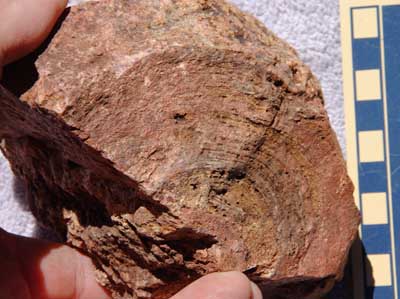 Click image to see Full Size
Click image to see Full Size
| A
fine concentric strom that started out as a very small round
bump in the center. |
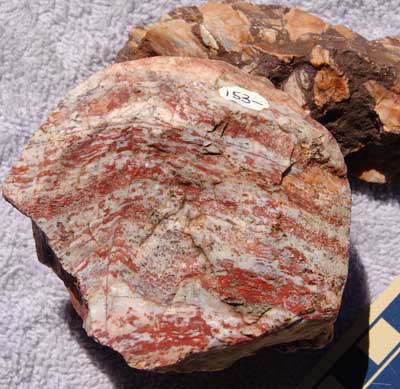 Click image to see Full Size
Click image to see Full Size
| Bright
reds on some of the stroms really show their colors. |
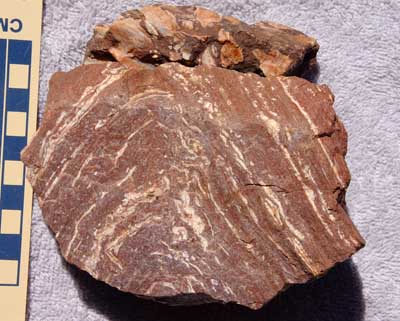 Click image to see Full Size
Click image to see Full Size
| One
of my favorites since the layers are composed of broken fragments
all in lines. |
Calcified Stromatolites from near Roosevelt Lake (Dego Springs Area)
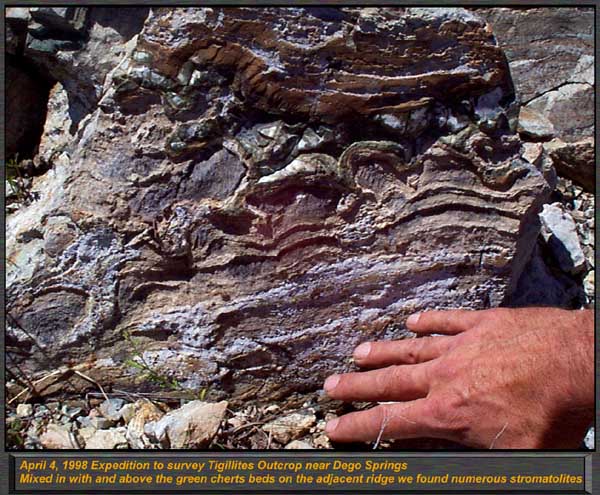 Click image to see Full Size
Click image to see Full Size
| On
a hill top, we found huge boulders and slabs of calcified stroms
in both parallel layers, and in huge bioherms. |
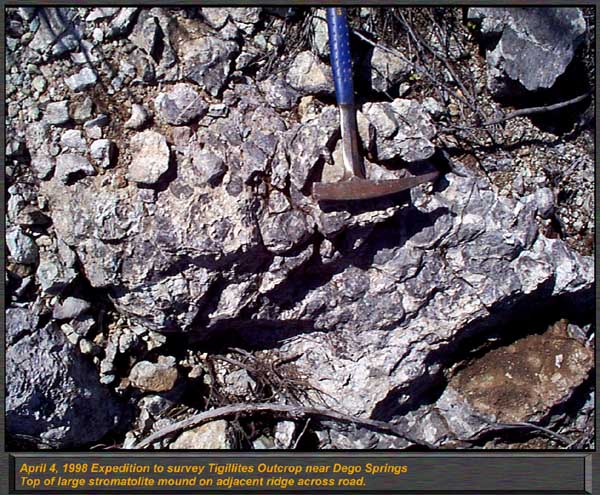 Click image to see Full Size
Click image to see Full Size
| Stroms
in outcrop. I was able to get one complete head off this cluster
in good shape. They dont break very easily on the point you hit,
so chisels were used to separate out individuals. |
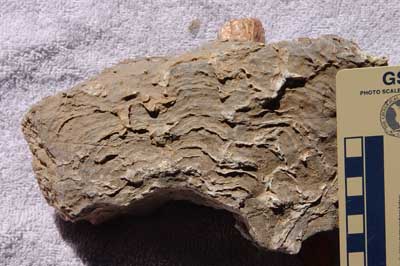 Click image to see Full Size
Click image to see Full Size
| One
of the larger specimens from Dego Springs. Gorgeous layers show
the growth of the strom over time, but never contain the algal
strands you find in the silicified material. |
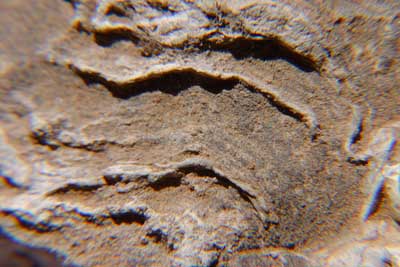 Click image to see Full Size
Click image to see Full Size
| Macro
close up of layers in the above specimen. |
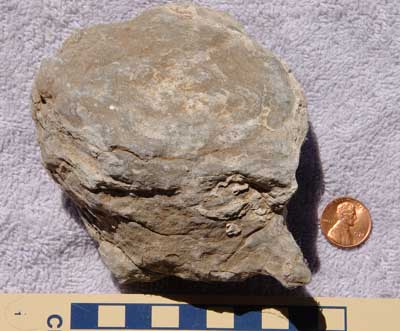 Click image to see Full Size
Click image to see Full Size
| One
of the nice small heads I removed from the big outcrop. |
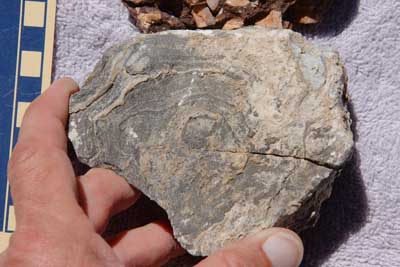 Click image to see Full Size
Click image to see Full Size
| Another
head, top view. |
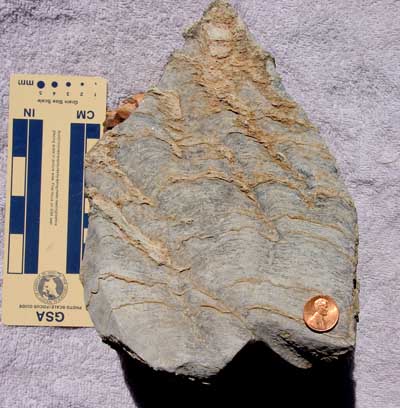 Click image to see Full Size
Click image to see Full Size
| Our
largest piece is also the finest one! This hefty specimen is
magnificent in details and complexity. |
Pseudo fossils found in a near by outcrop.
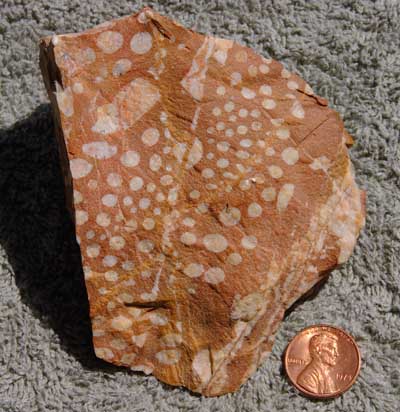 Click image to see Full Size
Click image to see Full Size
| This
locality contained what was called early in the 1900's as a trace
fossil from some sort of sea annelid worm called "Tigillites".
However subsequent analysis proved it was something quite different
- bubble escape structures. What you have is a decaying layer
underneath the mud, and as the methane bubbles build, they tend
to form tunnels through the overlying sediments seen here as
tubes of various sizes. The material is a nice chert, and some
lapidary folks make interesting jewelry out of this stuff. But
alas, it is NOT a fossil... |
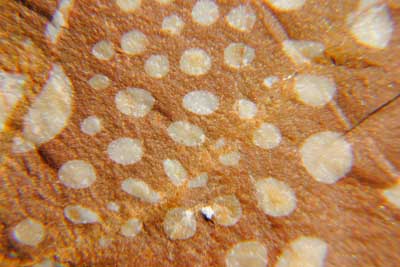 Click image to see Full Size
Click image to see Full Size
| Bubble
escape structures - holes on top of piece. |
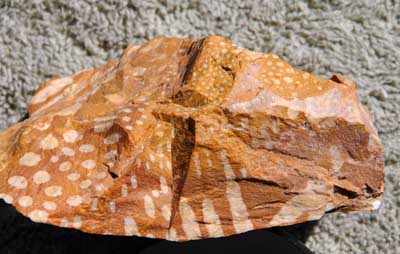 Click image to see Full Size
Click image to see Full Size
| Other
side of rock showing some very small holes too. Bubbles always
go up, and so the "tubes" are parallel. |
 Paleo HOME
Paleo HOME
|